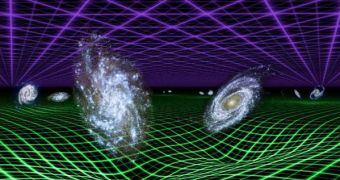A group of astronomers has just finished carrying out a large-scale census of galaxies across the Universe, in an effort that they hope will manage to evidence the existence of dark energy. This is the force that experts say is pulling the Cosmos apart at increasing speeds.
Dark energy was proposed by researchers in order to explain why galaxies seem to be flying away from each other, and also why the speed at which the Universe is expanding is increasing, rather than slowing down. These are basic questions in astronomy today.
But, during the new research project, experts surveyed more than 200,000 galaxies, and they hope that the data are enough to show that dark energy is real. The study was carried out over a period of 5 years.
Preliminary data appear to confirm that dark energy is indeed a constant, uniform force, that exerts its effects throughout the Universe, and leads to its faster and faster expansion. The work negates an alternate theory holding that gravity is pulling the Cosmos apart.
In order to conduct the new investigation, experts used the NASA Galaxy Evolution Explorer (GALEX) satellite and the Anglo-Australian Telescope (AAT) on Siding Spring Mountain, in Australia.
Galaxies surveyed during the research were as old as 7 billion years, which means that they developed when the Universe was only about half its current age. These objects too appear to confirm that dark energy is defeating gravity in terms of galactic interactions.
“The action of dark energy is as if you threw a ball up in the air, and it kept speeding upward into the sky faster and faster,” explains Swinburne University of Technology expert Chris Blake, who is based in Melbourne, Australia.
“The results tell us that dark energy is a cosmological constant, as Einstein proposed. If gravity were the culprit, then we wouldn't be seeing these constant effects of dark energy throughout time,” he adds, quoted by Space.
The researcher is also the lead author of two papers detailing the findings, which are scheduled for publication in an upcoming issue of the journal Monthly Notices of the Royal Astronomical Society.
Current calculations show that dark energy makes up about 74 percent of the entire Universe, with dark matter accounting for another 22 percent, and regular, baryonic matter making up just 4 percent.
“The Galaxy Evolution Explorer helped identify bright, young galaxies, which are ideal for this type of study. It provided the scaffolding for this enormous 3D map,” explains California Institute of Technology GALEX principal investigator Christopher Martin.

 14 DAY TRIAL //
14 DAY TRIAL //